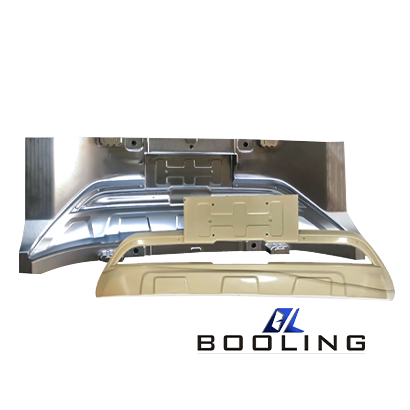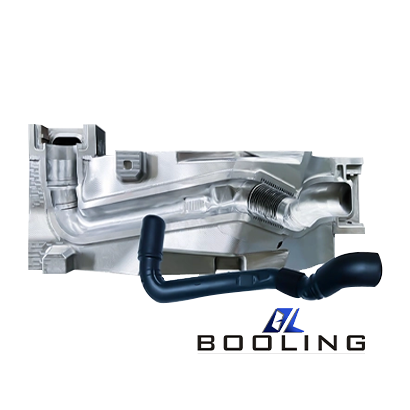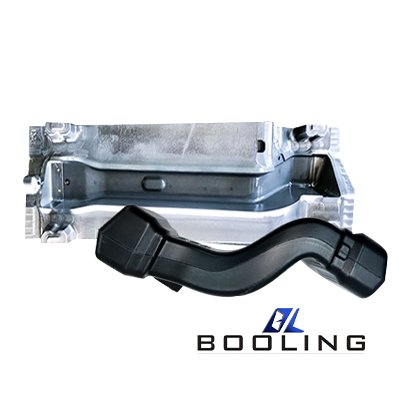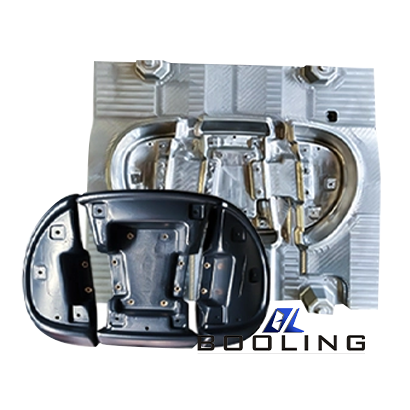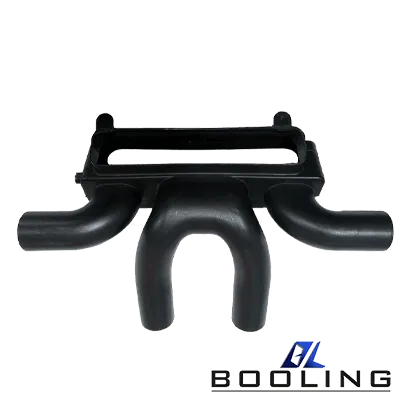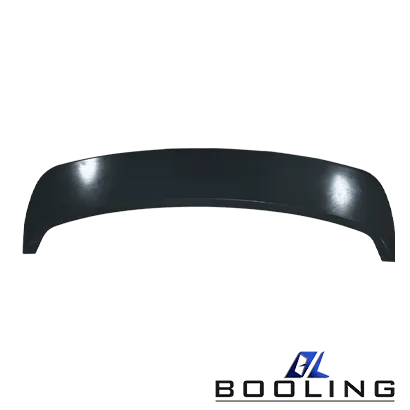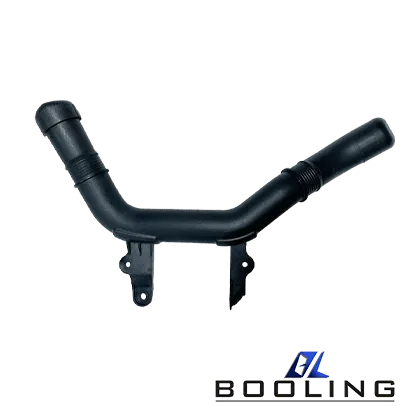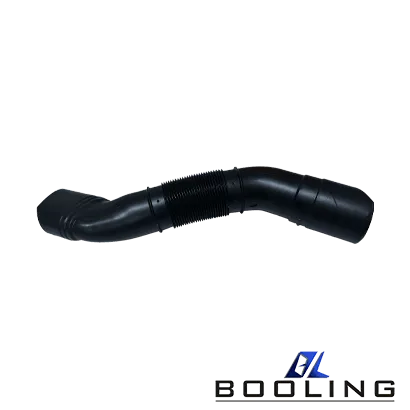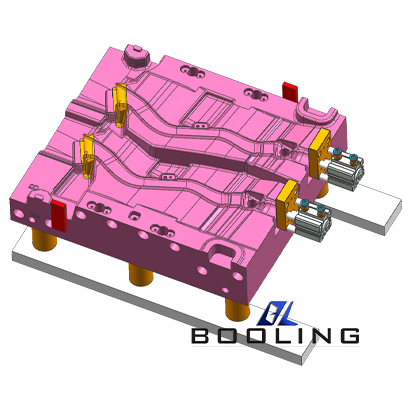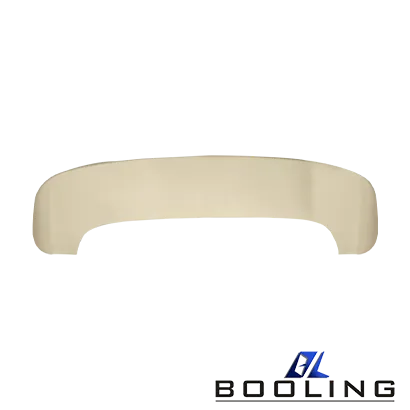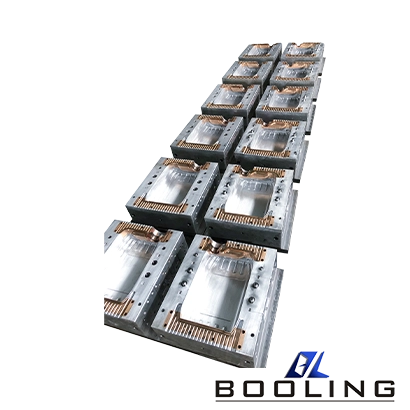Blow Molding Service
We conduct DMF technical analysis for customers based on product design, and with the professional technical support of our team, propose reasonable solutions before mold making. Booling blow molded products are more prone to shedding burrs, greatly improving production efficiency and facilitating workers to operate during stretching and blow molding processes in the workshop manufacture.
About BOOLING Blow Molding Service
Blow molding is an extrusion-based manufacturing technology where a molten plastic tube is inflated within a mold cavity, requiring specialized tooling and solutions from experienced manufacturers to produce hollow containers and parts.
The process of blow molding starts with the preheating and plasticization of thermoplastic materials. Then inject the completely melted plastic into the blow molding mold, which consists of two halves to form the desired product shape cavity. Once the mold is closed, compressed air is introduced to blow and expand the molten plastic mold to align with the mold cavity.
Common Materials for Blow Molding Services
Blow molding plays a crucial role in the manufacturing process of various plastic products. It is an important process in the blow molding industry that can accurately and efficiently manufacture seamless hollow objects. Blow molding is widely used in various industries, including packaging, automotive, toys, and household products.
Blow Molding Cases
FAQs about Blow Molding services
The blow molding mold is one of the most important blow molding tools, usually made of high-quality materials such as aluminum or steel, which can ensure the durability and lifespan of the mold. These molds have been carefully designed and manufactured to adapt to the required product dimensions and strict tolerances. By using blow molding technology, manufacturers can produce a variety of products, such as bottles, containers, and other hollow plastic products.
Which industries have Blow Molding applied?
- Jerrycans and Containers
One of the most common and well-known blow molding products is rudimentary plastic jerry cans and tanks. Whether it’s a jerrycan and tank quenching our thirst on a hot summer day or a shampoo bottle gracing our bathroom shelves, these seemingly simple items are the result of a complex blow molding manufacturing process.
- Beverage Bottles
Beverage bottles, especially those made from polyethylene terephthalate (PET) blow molded, are a typical example of the versatility and functionality of blow molding products. These bottles are not only lightweight and not easily broken but also have excellent barrier properties, ensuring the freshness and taste of the beverage.
The production of PET bottles involves a process called stretch blow molding, where a preform is first stretched longitudinally and then inflated inside a mold cavity. This technique results in bottles with exceptional strength, clarity, and resistance to gas permeation, making them ideal for carbonated beverages and other sensitive liquids.
- Household and Personal Care Products
From detergent tanks to lotion bottles, containers manufactured by blow molding have become an indispensable part of family and personal care procedures. These products are usually made of high-density polyethylene (HDPE) or polypropylene (PP) and have special properties such as durability, chemical resistance, and easy recycling.
The versatility of blow molding technology enables containers to create various shapes, sizes, and colors to meet the diverse needs of consumers and brands. Whether it’s hand sanitizer dispensers designed for fashion and ergonomics, or sturdy, leakproof household cleaner containers, blow molded products offer functionality and aesthetic appeal.
- Automotive Applications
In addition to the consumer goods sector, blow molding technology has also made significant progress in the automotive industry, significantly improving the safety, performance, and efficiency of automotive components. Whether it is the fuel tank or air duct, these components play a crucial role in ensuring the reliable and safe operation of the vehicle.
- Fuel Tanks
Fuel tanks are among the most critical blow molding components in modern automobiles. Typically made from high-density polyethylene (HDPE) or polyamide (PA), these tanks are designed to withstand extreme conditions, including impacts, temperature fluctuations, and exposure to fuel and other chemicals.
The blow molding process allows for the creation of seamless, leak-proof fuel tanks with complex shapes that conform to the vehicle’s design. These tanks not only ensure fuel efficiency and safety but also contribute to weight reduction, improving overall vehicle performance and fuel economy.
- Air Ducts and Intake Systems
The air ducts and intake systems in modern cars are usually manufactured using blow molding technology, which is mainly responsible for guiding air to the engine and cab. These components are often made from thermoplastic materials like polypropylene (PP) or polyamide (PA), which offer excellent heat resistance, durability, and chemical resistance.
The air ducts and intake systems produced by blow molding have complex shapes and smooth surfaces, which can optimize the size and direction of airflow, minimize turbulence, and improve engine performance and fuel efficiency. Additionally, these components play a crucial role in noise reduction, enhancing the overall driving experience.
- Industrial and Construction Applications
The versatility of blow molding technology goes far beyond the scope of consumer goods and automotive components. In the industrial and construction industries, these blow-molded products have become valuable assets with durability, chemical resistance, and cost-effectiveness.
- Storage Tanks and Drums
Large storage tanks are usually produced through blow molding processes, and manufacturers typically use materials such as high-density polyethylene (HDPE) or cross-linked polyethylene (PEX). These products are designed to store and transport a wide range of liquids and chemicals, from water and fuel to industrial solvents and chemicals.
The cans and drums manufactured by blow molding have a seamless structure and uniform wall thickness, ensuring their excellent strength and leak resistance, making them a preferred choice for demanding industrial applications. In addition, products produced by blow molding technology have the advantages of lightweight and easy operation, which helps to improve efficiency and reduce transportation costs.
- Drainage and Plumbing Systems
In the construction industry, blow molding products have become essential components in drainage and plumbing systems. Pipes, fittings, and other components made from materials like polyvinyl chloride (PVC) or high-density polyethylene (HDPE) offer excellent durability, chemical resistance, and cost-effectiveness.
The smooth interior surfaces of blow molding molded pipes minimize friction and turbulence, ensuring efficient fluid flow and reducing the risk of clogs or blockages. Additionally, these products are resistant to corrosion and environmental factors, making them suitable for underground installations and harsh conditions.
How to maintain blow molds?
1. Regular Inspections and Cleaning
Regular inspections and thorough cleaning of blow molding molds are crucial for maintaining their optimal performance. During these inspections, technicians should carefully examine the mold surfaces for signs of wear, such as erosion, scratches, or discoloration. Any defects or irregularities should be documented and addressed promptly.
Cleaning is an essential aspect of mold maintenance, as it removes residual plastic, contaminants, and buildup that can compromise the mold’s performance and lead to defects in the final products. Various cleaning methods can be employed, including manual cleaning, ultrasonic cleaning, or chemical cleaning, depending on the specific mold material and the nature of the contaminants.
2.Temperature and Pressure Monitoring
Maintaining optimal temperature and pressure conditions during the blow molding process is crucial for minimizing thermal and mechanical stress on the molds. Regularly monitoring and adjusting these parameters can help prevent excessive wear and ensure consistent product quality.
The temperature monitoring system can be used to track the mold temperature throughout the entire cycle, to promptly detect and adjust overheating or uneven cooling issues during the blow molding process. Similarly, pressure monitoring can help manufacturers identify any deviations from the optimal settings, enabling timely corrective measures to be taken to ensure the smooth progress of the blow molding process.
3.Lubrication and Cooling Systems
Proper lubrication and cooling systems play a vital role in extending the lifespan of blow molds. Lubrication helps reduce friction and wear between moving parts, while effective cooling systems prevent excessive heat buildup and thermal degradation.
Regular maintenance of lubrication systems, including the replacement of lubricants and the inspection of delivery mechanisms, is essential. Similarly, cooling systems should be inspected and maintained to ensure efficient heat dissipation and consistent cooling rates throughout the blow molding mold.
4.Mold Storage and Handling
Proper storage and handling practices are often overlooked but can significantly impact the longevity of blow molds. When not in use, molds should be stored in a clean, dry, and temperature-controlled environment to prevent corrosion, warping, or other forms of degradation.
Product application and manufacturing methods of blow molding in different industries
The basic principle of blow molding is similar to that of glass blowing. It mainly heats and melts plastic particles to form a preform, places it in a split mold, and blows the molten plastic with high-pressure gas to make it close to the inner wall of the mold. According to different process characteristics, blow molding is mainly divided into three types: extrusion blow molding, injection blow molding, and injection stretch blow molding. These various types of processes have their characteristics and are suitable for the production of different types of products.
Extrusion blow molding uses the rotation of the screw to fill the plastic raw material into the injection chamber. With the cooperation of the screw and the external heater, the softened and molten plastic is extruded into a hollow tube, and then the softened plastic is blown to the inner wall of the mold by high-pressure air, and finally, the excess part of the bottle mouth is removed. This method is suitable for producing products with complex shapes and large volumes.
Injection blow molding first makes a hot blank similar to injection molding and then blows the blank into the shape of the inner wall of the mold by high-pressure hot air. This method has the advantage that bottle blanks of different colors and sizes can be pre-made and stored, and high-speed blow molding production can be carried out according to demand.
Injection stretch blow molding is similar to injection blow molding, but an additional embryo drawing step is added before blow molding. This process can produce containers with a capacity of up to 10 liters, but the tolerance control requirements are high.
Blow molding applications in the packaging industry
The packaging industry is the most widely used application field for blow molding. Blow molding is mainly used to produce various plastic bottles, plastic barrels, plastic boxes, and other container products.
Beverage bottles are one of the most common blow molding products in the packaging industry, especially mineral water bottles, which are mainly produced by injection stretch blow molding using PET materials. This process first injects PET plastic into a preform, and then stretches and blows it in the blow molding process to obtain a beverage container with high strength, good transparency, and lightweight. This method can effectively control the uniformity of the bottle wall thickness while improving the mechanical properties of the material.
Blow molding technology is also widely used in cosmetic packaging and detergent containers, mainly using high-density polyethylene (HDPE) or polypropylene (PP) materials, and produced by extrusion blow molding. These products have high requirements for chemical resistance and environmental stress cracking resistance of materials, and the blow molding process can meet these requirements while achieving complex shape designs and color changes.
Blow molding technology is also widely used in food packaging containers such as cooking oil bottles, condiment bottles, and jam jars. These products usually need to meet food-grade safety standards and have good airtightness and leak-proof properties. Blow molding can achieve these characteristics in an integrated molding process, avoiding the risk of leakage that may be caused by using multiple pieces for assembly.
Packaging industry: container and bottle manufacturing
1. Beverage bottles (PET material)
– Product specifications: 300ml-2L carbonated beverage bottles, mineral water bottles
– Manufacturing process: biaxial stretch blow molding (injection stretch blow molding)
(1) Process steps:
a. Injection molding prefabricated tube (wall thickness accuracy ±0.1mm)
b. Preheat to 110-120℃ for longitudinal stretching (stretching ratio 2.5:1)
c. Blowing transverse stretching (blowing ratio 3:1), molding temperature 85-105℃
(2) Key technologies:
a. The mold is made of beryllium copper alloy (thermal conductivity 105W/m·K), cooling rate ≥15℃/s
b. Bottle mouth thread accuracy is ±0.02mm, and the sealing test pressure is ≥1.5MPa
2. Chemical barrels (HDPE material)
– Product specifications: 5-200L industrial chemical containers
– Manufacturing process: extrusion blow molding
(1) Process parameters:
– Extruder screw L/D ratio 28:1, melt temperature 200-230℃
– Blowing pressure 0.6-1.0MPa, holding time 30-60 seconds
(2) Structural design:
– Rib depth 8-12mm, improve drop resistance (pass 1.8m drop test)
– Double-layer sealing structure, anti-leakage level IP67
Blow molding products in the daily necessities industry
In terms of household products, blow molding technology is widely used in the production of buckets, flower pots, teapots, storage boxes, and other products. These products are usually made of polyethylene or polypropylene using extrusion blow molding. Extrusion blow molding is particularly suitable for manufacturing these large-volume products with uniform wall thickness. The strength and hardness of the finished product can be controlled by adjusting the thickness of the parison during the production process.
Bathroom products such as hand soap bottles, shower gel bottles, shampoo bottles, etc. are also produced using blow molding technology. This type of product usually needs to have extrusion resistance and good appearance quality and is mostly manufactured by injection blow molding or injection stretch blow molding. During the production process, mold design plays a key role in the appearance and function of the product, especially the bottle mouth design and pump head connection structure need to be precisely controlled.
Kitchen supplies such as seasoning bottles, oil bottles, juice bottles, etc. are also important application areas of blow molding technology. During the manufacturing process of these products, different plastic materials and blow molding processes can be selected according to different usage requirements. For example, a juice bottle that requires a transparent effect can use PET material and injection stretch blow molding; while an oil bottle that requires heat resistance may use PP material and use extrusion blow molding.
Home furnishing industry: daily necessities and decorative parts
1. Hollow toys (PP material)
– Product features: wall thickness 1.2-2.5mm, impact strength ≥40kJ/m²
– Manufacturing process: extrusion blow molding + in-mold labeling
(1) Structural innovation:
– Multi-slide mold molding movable joint parts
– In-mold transfer technology to achieve surface pattern (resolution 1200dpi)
(2) Safety design:
– Chamfer radius ≥1mm, in line with EN71-1 standard
– Heavy metal content passed the CPSC test
2. Furniture components (ABS material)
– Product features: imitation wood grain surface, load-bearing ≥200kg
– Manufacturing process: gas-assisted blow molding
(1) Process parameters:
– Gas pressure 8-12MPa, injection time 3-5 seconds
– Pressure holding stage gas pressure maintained at 4-6MPa
(2) Surface treatment:
– Mold etching (depth 0.2mm) simulates wood grain
– UV coating hardness ≥ 3H (pencil hardness)
Toy and children’s products industry
The toy industry is one of the important application areas of blow molding technology. Blow molding process can produce children’s toy products with various shapes and rich colors.
Toy cars are a typical application of blow molding technology. Through the extrusion blow molding process, hollow bodies and tires can be molded in one step. During the production process, the thermoplastic material is first extruded into a blank, and then the blank is placed in the body mold. The plastic is blown up by high-pressure gas to make it close to the inner wall of the mold. The toy car body taken out after cooling is an integrated hollow structure, which can be assembled and painted later.
Blow molding technology is also widely used in baby products such as rattles, bathtubs, and baby bottles. In particular, baby bottles are usually made of polypropylene materials and manufactured by injection blow molding. This process can ensure the safety and hygiene of the product while having good transparency and heat resistance. The manufacturing process requires strict control of material selection and the cleanliness of the production environment to meet the strict standards of baby products.
Children’s amusement equipment such as slides, swing seats, small playhouses, and other large hollow structure products can also be produced by blow molding technology. Such products usually adopt an extrusion blow molding process and use high-density polyethylene materials, which can reduce product weight and improve safety while ensuring sufficient strength. During the manufacturing process, mold design and plastic material selection play a key role in the strength, durability, and safety of the product.
Chemical and industrial container field
Chemical storage barrels are an important application of blow molding technology. They are usually made of high-density polyethylene materials and manufactured by extrusion blow molding process. This process can produce large containers with a capacity ranging from a few liters to hundreds of liters. The products have excellent chemical corrosion resistance and sufficient mechanical strength. During the manufacturing process, special attention should be paid to the chemical resistance and environmental stress cracking performance of the material. Blow-molded plastic containers perform better in this regard than injection-molded products.
Industrial oil barrels and lubricating oil containers are also important applications of blow molding technology. They are usually produced by extrusion blow molding process. Such products need to have good sealing performance and oil resistance. The bottle mouth structure and wall thickness distribution need to be precisely controlled during the manufacturing process. Especially for large containers, special blow molding machines, and process parameters are required during the blow molding process to ensure uniform wall thickness and sufficient strength of the product.
Blow molding technology is also widely used in dangerous goods transport containers such as pesticide bottles and disinfectant bottles. Such products usually use a multi-layer blow molding process to form a multi-layer structure by co-extrusion of plastic materials with different functions, which can not only provide the necessary barrier properties but also ensure the strength and chemical stability of the product. During the manufacturing process, the thickness ratio and bonding strength of the multi-layer materials need to be specially controlled to ensure that the product performance meets strict safety standards.
Industrial field: Special container manufacturing
1. IBC barrel (HDPE material)
Product specifications: 1000L, stacking height ≥ 5 layers
Manufacturing process: large-scale extrusion blow molding
(1) Mold technology:
– Segmented heating system (20 temperature control zones)
– Hydraulic ejection system (ejection force ≥ 20 tons)
(2) Structural reinforcement:
– Steel-plastic composite frame structure, UN certified
– Anti-ultraviolet additives (content 0.3%-0.5%)
2. Automobile urea tank (PA6 material)
– Product features: hydrolysis resistance, low-temperature impact resistance (-40℃)
– Manufacturing process: in-mold foaming blow molding
(1) Process innovation:
– Supercritical N₂ foaming technology (foaming rate 15%-25%)
– In-mold welding liquid level sensor bracket
(2) Weather-resistant design:
– Surface fluorine coating (thickness 5-8μm)
– Chemical corrosion resistance test (40% urea solution, 1000h)
Automobile and transportation industry applications
Automobile ducts and air intake systems are typical applications for blow molding. These parts are usually made of high-density polyethylene or nylon materials using extrusion blow molding. During the manufacturing process, special attention should be paid to the temperature tolerance and mechanical strength of the product, while ensuring the smoothness and dimensional accuracy of the inner wall of the duct. Blow molding technology can form complex three-dimensional curved pipes in one go, avoiding the trouble of traditional multi-section pipe connections.
Automobile fuel tanks are also an important application of blow molding technology. Most modern automobile fuel tanks are manufactured using a multi-layer blow molding process, which usually includes an anti-permeation layer, a barrier layer, and a structural layer. The manufacturing process uses special extrusion blow molding equipment that can extrude multiple layers of material at the same time to form a composite parison, and then blow mold the complete fuel tank structure. This process not only ensures the sealing and safety of the fuel tank but also enables complex internal structure designs, such as integrated wave plates and liquid-level sensor installation locations.
Large plastic parts such as wheel covers and bumpers can also be manufactured using blow molding technology. These parts are usually made by extrusion blow molding using polypropylene or modified polyolefin materials. During the manufacturing process, the wall thickness distribution and cooling rate of the product need to be carefully controlled to avoid deformation and warping. The advantage of blow molding is the ability to manufacture large and lightweight parts while maintaining sufficient rigidity and strength.
Automotive industry: functional component manufacturing
1. Fuel tank (multi-layer HDPE)
– Product features: 60-120L volume, fuel permeability <0.15g/24h
– Manufacturing process: co-extrusion blow molding
(1) Layer structure: HDPE/EVOH barrier layer/adhesive layer (6-layer structure, total thickness 3-5mm)
(2) Key technologies:
– In-mold high-pressure molding (1.2-1.5MPa) to achieve complex curved surface structure
– Laser welding fuel pump mounting seat, position accuracy ±0.3mm
(3) Testing standards:
– Burst pressure ≥35kPa (ISO 3994)
– Vibration fatigue test (1 million times @50Hz)
2. Air conditioning duct (TPV material)
– Product features: temperature range -40℃~150℃, bending life ≥500,000 times
– Manufacturing process: 3D blow molding
– Process innovation:
– Multi-axis robot traction technology, forming special-section pipes
– In-mold insert technology, integrated metal connectors
– Mold design:
– Parting surface conformal design, reducing flash
– Cooling water channel adopts conformal drilling technology, temperature difference ±2℃
Construction and pipeline material field
Plastic drain pipes and water pipes are typical applications of blow molding technology. These products are usually made of PVC or polyethylene materials using an extrusion blow molding process. During the manufacturing process, the plastic material is first extruded into a blank and then blown into shape in the mold. Blow molding technology can produce pipe products with uniform wall thickness and smooth inner walls, which are suitable for fluid transportation requirements. Especially for large-diameter pipes, the blow molding process has obvious advantages over the traditional extrusion process.
Building decorative components such as hollow columns, decorative covers, etc. can also be manufactured by blow molding technology. Such products are usually made of polypropylene or engineering plastic materials using an extrusion blow molding process. During the manufacturing process, special attention should be paid to the surface quality and dimensional accuracy of the product. Blow molding can produce lightweight hollow structures, which not only meet the requirements of decorative effects but also reduce the difficulty of installation and material costs.
Blow molding technology is also widely used in environmental protection facilities such as rainwater collection systems and septic tanks. Such products are usually large and are made of high-density polyethylene materials using extrusion blow molding. During the manufacturing process, large-scale blow molding equipment and special molds are required to control the material distribution and cooling rate to ensure that the product has sufficient strength and durability. The advantage of blow molding is that it can form complex hollow structures in one go, avoiding the risk of leakage that may be caused by traditional assembly processes.
Application in the agricultural field
Agricultural spraying equipment such as sprayer containers and pesticide barrels are typical applications of blow molding technology. These products are usually made of high-density polyethylene materials using extrusion blow molding. During the manufacturing process, special attention should be paid to the chemical stability and environmental stress-cracking performance of the products. Blow molding technology can produce chemically resistant and long-lasting container products to meet the harsh environmental requirements of agricultural production.
Irrigation system accessories such as drip irrigation pipe joints and water distributors are also made using blow molding technology. These products are usually produced by injection blow molding using polypropylene or nylon materials. During the manufacturing process, the size and shape of the product need to be precisely controlled to ensure good connection performance. Blow molding technology can produce hollow parts with complex internal structures and good sealing performance, which are suitable for the requirements of water conservancy systems.
Large agricultural storage containers such as fertilizer troughs and feed silos can also be produced by blow molding technology. These products are usually produced by extrusion blow molding. Blow molding technology uses high-density polyethylene materials. During the manufacturing process, large-scale blow molding equipment and special mold structures are required to ensure uniform wall thickness and sufficient strength of the product. The advantage of blow molding is that it can produce large one-piece containers, avoiding the leakage and maintenance problems that may be caused by traditional multi-piece assembly.
Furniture and leisure facilities field
The furniture and leisure facilities industry is also an important application field of blow molding technology, and various hollow structure products are manufactured by blow molding.
Leisure furniture such as outdoor chairs and camping tables are typical applications of blow molding technology. These products are usually manufactured using extrusion blow molding technology and high-density polyethylene materials. During the manufacturing process, by controlling the thickness distribution of the parison and the blow molding parameters, different wall thicknesses can be formed in different parts of the product to enhance the strength of key parts. The advantage of blow molding is that it can produce lightweight and weather-resistant outdoor furniture to meet consumers’ dual needs for portability and durability.
Stadium seats are another important application of blow molding technology. Such products usually use extrusion blow molding technology, use high-density polyethylene materials, and add UV stabilizers and impact modifiers. During the manufacturing process, special attention should be paid to the weather resistance and impact resistance of the product. Blow molding can produce a one-piece hollow structure seat, with internal reinforcement ribs to improve strength, a smooth external surface for easy cleaning, and good elasticity and comfort.
Blow molding technology is also widely used in decorative flower pots and flower boxes. Such products usually adopt an extrusion blow molding process, using polypropylene or polyethylene materials, and various pigments and additives can be added to achieve different colors and textures. During the manufacturing process, various complex surface textures and shapes can be achieved by adjusting the blow molding parameters and mold design. The advantage of blow molding technology is that it can produce lightweight, impact-resistant, and weather-resistant flower pot products to meet the use needs of various indoor and outdoor environments.
Guidelines for Blow Molding services
BOOLING is a professional blow molding manufacturer. Our process is suitable for the production of various hollow products such as bottles, oil drums, and water buckets. The mold engineer mainly places the molten plastic parison in the mold and injects high-pressure gas into it to expand and fit the inner wall of the mold, and finally cools and shapes it into the desired shape.




